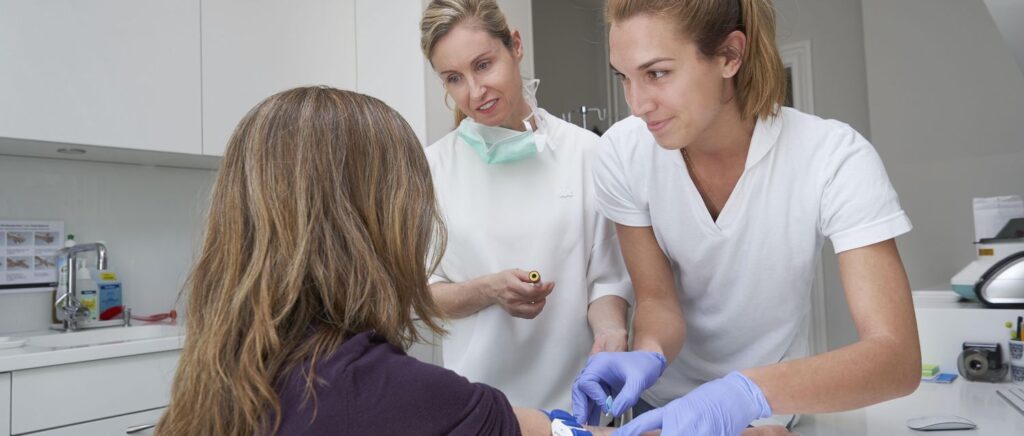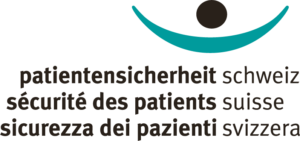Patient safety in the outpatient setting
For a long time, patient safety initiatives focused only on the inpatient sector. Therefore, the outpatient segment has still work to do and is one of the Foundation’s priority areas.

The outpatient sector becomes more important
- The majority of patient contacts take place in the outpatient sector.
- Hospital stays are becoming shorter, follow-up and further treatment are being shifted.
- Therapies are increasingly being carried out on an outpatient basis, including complex treatments.
- The number of chronically and multiply ill patients increases the need for outpatient care.
According to the OECD, safety problems are common in the outpatient sector.
- Up to four out of ten patients are harmed in the course of their outpatient care.
- Up to 80% of patient harm is preventable.
- The additional costs amount to about 2.5% of national health expenditure.
Catching up on research and developments
More in-depth knowledge about the development and prevention of safety issues in the outpatient sector is needed. Suitable measures must be developed and implemented. Together with the FMH, the Foundation has developed an outline of approaches and measures for the promotion of patient safety in outpatient medical care. This forms the basis for further activities and projects.
Patient safety in outpatient surgery

How often do adverse events occur in medical surgeries? What is important when dealing with second victims? What principles are central to learning from errors? An initial set of measures for outpatient surgeries serves as a baseline when dealing with patient safety in this sector of care. The module «Patient Safety in the Medical Practice»in German and French offers basic knowledge and targets the crucial starting points, such as «communication after an event» or «learning from errors». In addition, a brochure is available for facilitators who would like to work with the materials.
Quality circles, practice team meetings and other gatherings of professionals in particular provide the appropriate setting for patient safety measures and thus the use of the materials. The project was carried out in collaboration with and with the financial support of the FMH Medical Association.
The module «Patient Safety in Medical Practice» in German and French consists of 2 parts and 5 chapters, which can be used as a series of topics or individually:
Part 1
Chapter A: Central terms and concepts
Chapter B: Adverse events in the medical practice
Part 2
Chapter C: When something does go wrong
Chapter D: Support for so-called second victims
Chapter E: Learning from errors
Current projects
Room of Horrors
Aufmerksamkeit für Patientensicherheitsrisiken lässt sich trainieren: in einem Room of Horrors. Im Trainingsraum werden Fehler und Risiken für die Patient:innensicherheit versteckt. Mitarbeitende versuchen einzeln oder im Team, diese aufzudecken.
Other projects related to the outpatient sector
Speak Up
Health Information Technology (HIT)
CIRS
Completed projects
Risks in primary care
Patient Safety Switzerland conducted a study on risks in primary care with over 400 practices.
The study resulted in relevant findings regarding the nature and frequency of safety problems in outpatient healthcare. The project developed an instrument to survey the safety culture in primary care.
The following areas proved to be particularly relevant for action:
- Diagnostic errors
- Medication errors
- Errors in monitoring patients in the practice
- Errors in tests and interventions
- Concern: Triage when patients contact the clinic by telephone
Telephone triage in primary care
Telephone triage when contacting a doctor’s office is a hot-spot of patient safety. Misjudgments of the urgency of the patient’s concern are not uncommon.
The risk associated with telephone triage is of great importance for both doctors and MPAs. International studies are also increasingly pointing this out. Patient Safety Switzerland therefore launched the project safety of telephone triage in primary care in 2013, in which a practical guide for primary care practices was developed.
Guideline for staff in primary care practices
The guidelines are a working tool that guides practice teams in analyzing the structures and framework conditions surrounding telephone triage and its effects on patient safety. In a second step, measures can be developed to strengthen the safety of telephone triage in the practices. The core of the guide consists of seven modules on the topics: Expectations in the practice team, questions for the doctor, feedback for the MPA, communication and communication vessels, case discussions, learners in the practice and work (place) design.
Pharmacy customers with a migration background
Incidents in connection with medicines are particularly frequent among migrants because of the often limited communication.
Pharmacies play an important role in the health care of migrants. A study conducted by Patient Safety Switzerland in 2012 showed that pharmacists surveyed consider the drug therapy of migrants to be less safe than that of other customer groups. Improvement measures are consequently required. Pharmacists are very interested in tools such as labelling software and online texts in foreign languages, but also pictograms and illustrated instruction templates. Based on the study results, a further training module on the topic of «Religious and linguistic diversity in the pharmacy» was developed by an external provider.
Pharmacies as a source of information
Transitions between treatment sectors are dangerous phases for medication safety. Systematic medication reconciliation is an effective measure.
Since patients often use pharmacies as their regular pharmacy, this pharmaSuisse-funded project in 2015 aimed to explore the role and possibilities of pharmacies as a source of information for the collection of medication history on hospital admission. The study showed that surveyed pharmacies have a good knowledge of regular customers, although there are also information gaps. Pharmacies thus have information that is important for compiling a complete pre-hospital medication list. They would be willing to participate more in this, but would also like information at hospital discharge. The exchange of information between pharmacies and hospitals could therefore improve medication safety; the areas of data protection, information transfer and processes, as well as a mutual recognition of competences, must be discussed and clarified. You can find more information regarding this subject in the Executive Summary (in german).
Patient safety in the outpatient setting
For a long time, patient safety initiatives focused only on the inpatient sector. Therefore, the outpatient segment has still work

